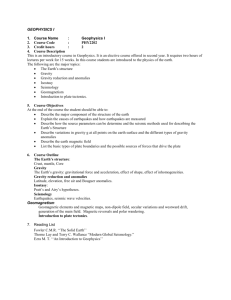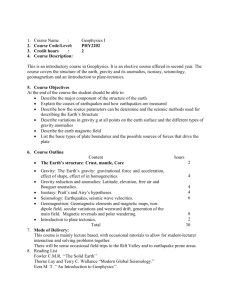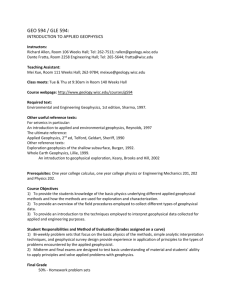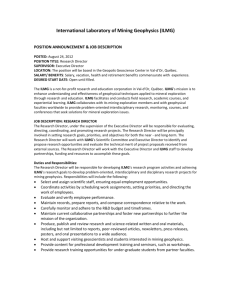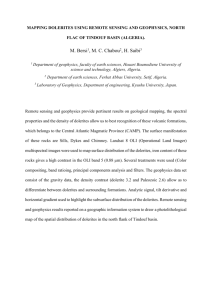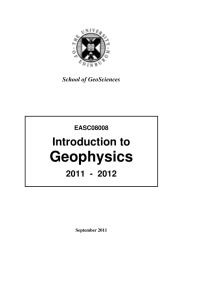Outline of Geophysics 325
advertisement
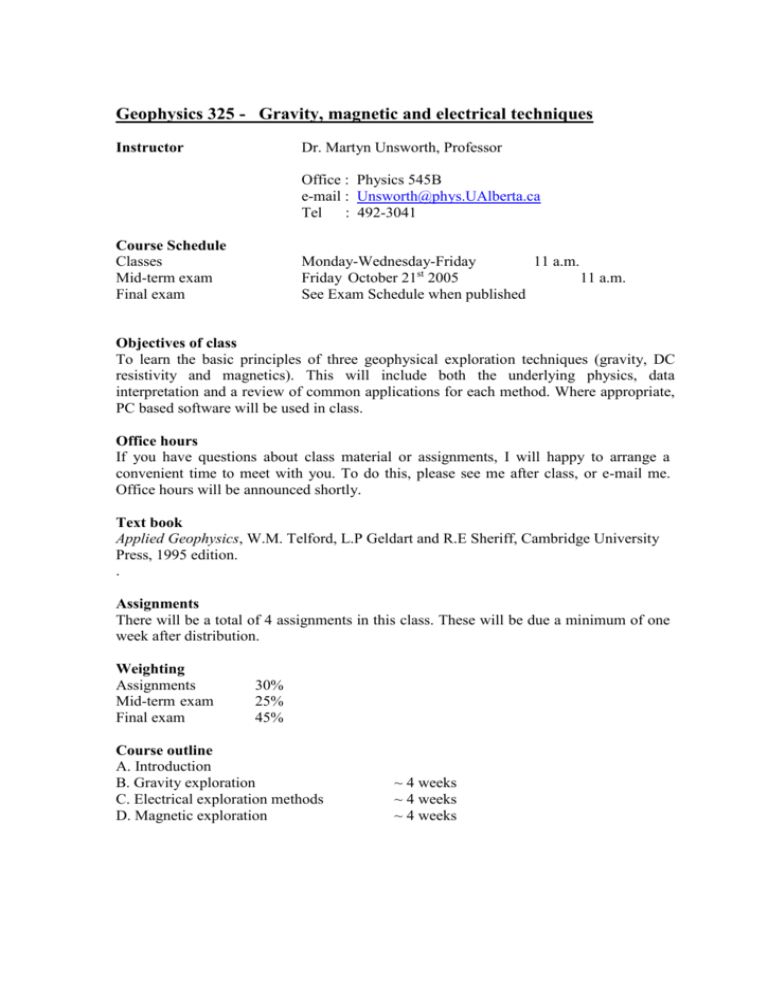
Geophysics 325 - Gravity, magnetic and electrical techniques Instructor Dr. Martyn Unsworth, Professor Office : Physics 545B e-mail : Unsworth@phys.UAlberta.ca Tel : 492-3041 Course Schedule Classes Mid-term exam Final exam Monday-Wednesday-Friday 11 a.m. Friday October 21st 2005 11 a.m. See Exam Schedule when published Objectives of class To learn the basic principles of three geophysical exploration techniques (gravity, DC resistivity and magnetics). This will include both the underlying physics, data interpretation and a review of common applications for each method. Where appropriate, PC based software will be used in class. Office hours If you have questions about class material or assignments, I will happy to arrange a convenient time to meet with you. To do this, please see me after class, or e-mail me. Office hours will be announced shortly. Text book Applied Geophysics, W.M. Telford, L.P Geldart and R.E Sheriff, Cambridge University Press, 1995 edition. . Assignments There will be a total of 4 assignments in this class. These will be due a minimum of one week after distribution. Weighting Assignments Mid-term exam Final exam 30% 25% 45% Course outline A. Introduction B. Gravity exploration C. Electrical exploration methods D. Magnetic exploration ~ 4 weeks ~ 4 weeks ~ 4 weeks Statement on academic integrity "The University of Alberta is committed to the highest standards of academic integrity and honesty. Students are expected to be familiar with these standards regarding academic honesty and to uphold the policies of the University in this respect. Students are particularly urged to familiarize themselves with the provisions of the Code of Student Behaviour (online at www.ualberta.ca/secretariat/appeals.htm) and avoid any behaviour which could potentially result in suspicions of cheating, plagiarism, misrepresentation of facts and or participation in an offence. Academic dishonesty is a serious offence and can result in suspension or expulsion from the University." (GFC 29 SEP 2003) Grading in Undergraduate Courses Description Letter Grade Grade Point Value ____________________________________________ Excellent A+ 4.0 A 4.0 A3.7 ____________________________________________ Good B+ 3.3 B 3.0 B2.7 ____________________________________________ Satisfactory C+ 2.3 C 2.0 C1.7 ____________________________________________ Poor D+ 1.3 Minimal Pass D 1.0 ____________________________________________ Failure F 0.0 Policy about course outlines can be found in Section 23.4(2) of the University Calendar (CGF 29 SEP 2003) MJU 2005 GEOPHYSICS 325 – References (1) Recommended textbook Applied Geophysics, W.M. Telford, L.P Geldart and R.E Sheriff, Cambridge University Press, 1995 edition. Good overall reference book with detailed mathematical derivations. (2) Textbooks covering electromagnetic and potential field methods Physical principles of exploration methods, A.E. Beck, Wuerz Publishing, 1991. Concise treatment with an adequate mathematics. Unfortunately, it is now out of print. Exploration Geophysics of the shallow subsurface, H.R. Burger, Prentice-Hall, 1992. Good book, but not as mathematically rigorous as other titles. Includes software for Macintosh that is quite useful. (3) Detailed books on electrical and electrical methods Electrical methods in Geophysical Prospecting, Keller and Frischknecht, Pergammon, 1966. An old book but gives detailed mathematics and a historical perspective. (4) Detailed books on potential field methods Potential Theory in Gravity and Magnetic Applications, Richard Blakley, Cambridge University Press, 1995. A review of potential field theory that combines rigorous mathematics and practical applications. Describes shape of geoid, isostacy and has a focus on whole-Earth geophysics. Also gives an introduction to inverse methods useful for gravity and magnetic datasets Geologic Applications of gravity and magnetics : Case Histories, edited by R.I. Gibson and P.S. Millegan, Society of Exploration Geophysicists, 1998. A useful book that shows how potential field methods are used today in the oil industry. Good figures and discussions of interpretation philosophy. (5) Textbooks describing physics of the Earth and plate tectonics The Solid Earth, Mary Fowler, Cambridge University Press, First edition 1990 (6) Internet resources http://galitzin.mines.edu/INTROGP/index.jsp SEG funded site developed at Colorado School of Mines. Covers gravity, magnetics, seismic refraction and DC resistivity. Limited mathematics, but good diagrams and very practical applications. MJU August 2005

